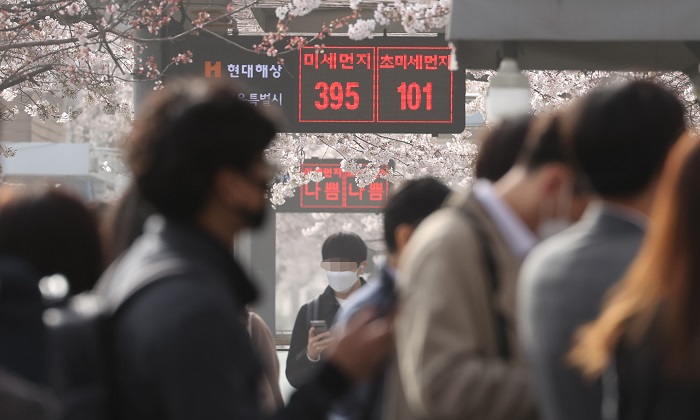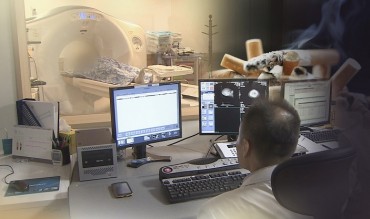
An electronic board in Seoul on March 29, 2021, shows the density levels of fine and ultrafine particulate matter (PM) reaching 395 micrograms per cubic meter and 101 micrograms per cubic meter, respectively, as a yellow dust storm causes the density of harmful particles to increase, with a yellow dust warning issued for the South Korean capital. (Yonhap)
SEOUL, April 22 (Korea Bizwire) — The state-run Korea Atomic Energy Research Institute said Wednesday that it has developed a new technology that analyses radioactive particles in fine dust and uses them to track down the source of the contaminant.
The new technology places a marker to measure the changes in radioactive levels inside fine dust, and analyze the contaminant.
Out of some 60 elements that form fine dust, the institute measured five kinds of radioactive isotopes.
Among them, the institute discovered beryllium-7 (Be-7), lead-214 (Pb-214), and lead-212 (Pb-212) that can be used as markers.
Radioactive isotopes have an identical number of protons as those in natural elements, but differ in the number of neutrons, resulting in different mass.
Unlike iron or aluminum, these isotopes have a half-life cycle, during which the amount of radiation changes as time passes, making them useful markers to track down the contaminant source.
Beryllium-7 is made in the stratosphere, and comes down to the Earth’s surface with dust.
Most of the fine dust that occurs in China heads up to higher altitudes to travel across long distances, during which it is assumed to collect an ample amount of beryllium-7.
Lead-214 and lead-212, on the other hand, are produced in the form of gas from the Earth’s crust, and have short half-life cycles.
Since they prevent these isotopes from travelling across long distances, it is assumed that only the fine dust that occurs within the Korean peninsula will contain these isotopes.
The new technology is expected to help track down the source of fine dust from China by analyzing the proportion of nuclides that have short or long half-life periods in fine dust, as well as those that cannot be found in the country.
H. M. Kang (hmkang@koreabizwire.com)






